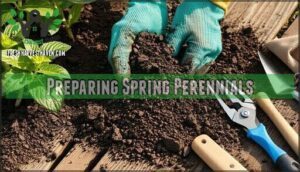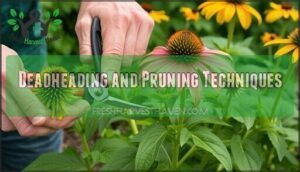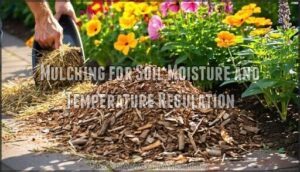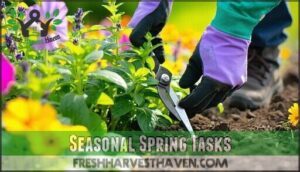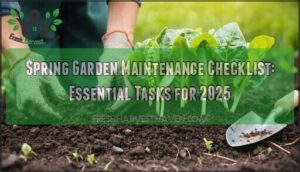This site is supported by our readers. We may earn a commission, at no cost to you, if you purchase through links.
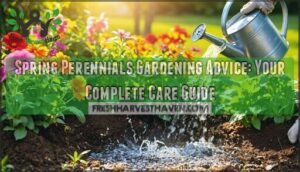 Spring perennials gardening advice starts with timing – clean up beds after your last frost, but don’t rush it.
Spring perennials gardening advice starts with timing – clean up beds after your last frost, but don’t rush it.
Remove dead foliage from hardy perennials like hostas and daylilies, leaving ornamental grasses until new growth appears.
Divide overcrowded clumps every 3-4 years for healthier plants and more blooms.
Apply 2-3 inches of mulch around plants, keeping it away from stems to prevent rot.
Feed with balanced fertilizer when new shoots emerge, and water deeply but less frequently to encourage strong root systems.
The secret lies in understanding each plant’s unique spring awakening schedule and matching your care to their natural rhythms.
Table Of Contents
- Key Takeaways
- Spring Perennial Basics
- Preparing Spring Perennials
- Planting Spring Perennials
- Spring Perennial Care
- Seasonal Spring Tasks
- Frequently Asked Questions (FAQs)
- How to prepare a perennial garden for spring?
- What do you do with perennials in the spring?
- When should I fertilize perennials in the spring?
- What is the 3 year rule for perennials?
- What are the best perennials to plant in the spring?
- Should you fertilize perennials in the spring?
- What to do with perennials in the spring?
- What is the 3 year perennial rule?
- Do all perennials need to be cut back in the spring?
- When should I plant perennials in the spring?
- Conclusion
Key Takeaways
- Time your spring cleanup properly – Wait until after your last frost date to remove dead foliage from hardy perennials, but leave ornamental grasses until you see new growth emerging.
- Divide overcrowded clumps every 3-4 years – You’ll get healthier plants and more blooms by dividing perennials when they become crowded or flowering diminishes.
- Apply mulch correctly for moisture retention – Use 2-3 inches of organic mulch around plants, keeping it away from stems to prevent rot while reducing water evaporation by up to 70%.
- Water deeply but less frequently – You’ll encourage stronger root systems by providing 1-1.5 inches of water weekly (including rainfall) rather than frequent shallow watering.
Spring Perennial Basics
You’ll discover that spring perennials offer a reliable foundation for your garden, returning year after year with beautiful blooms while requiring less maintenance than annuals.
Understanding their lifecycle phases and soil needs helps you create the perfect growing conditions for decades of colorful displays.
Perennial Lifecycle Phases
Perennial plants progress through three main growth stages each year, creating a predictable bloom cycle that gardeners can count on.
During spring, your perennials emerge from dormancy as warming soil triggers root establishment and new shoot development.
The bloom duration varies by species, with some flowering for weeks while others offer brief but spectacular displays.
As seasonal changes occur, these hardy plants develop dormancy adaptations, storing energy in their root systems.
Lifespan factors like proper care and suitable growing conditions help perennials return reliably year after year, making the garden plant lifecycle both efficient and rewarding for long-term planning.
Benefits of Perennials
Spring perennials offer remarkable advantages that make them smart gardening investments.
You’ll reduce waste by eliminating annual replanting, while these hardy plants provide consistent cost savings year after year.
Once established, perennial plants require less maintenance than annuals, needing minimal water and fertilizer.
Your spring flowers create essential pollinator support, attracting bees and butterflies that boost biodiversity throughout your garden ecosystem.
Gardeners should also consider companion planting strategies to naturally enhance growth.
Soil Requirements for Perennials
Successful perennial gardens start with understanding your soil’s foundation.
Well-drained soil prevents root rot in most species, while proper soil preparation guarantees healthy growth.
Test your soil drainage—water should disappear within 24-48 hours after rainfall. Amend heavy clay with compost to improve soil health, and consider raised beds for poor drainage areas.
Understanding the USDA gardening zones is also essential for selecting suitable perennials.
Optimal PH Levels for Perennials
While testing soil might seem like an extra step, it’s your secret weapon for thriving spring perennials advice.
Most perennials flourish in pH ranges between 6.0-7.0, though specific plants have unique needs.
Here are ideal ranges for common varieties:
- Acid-loving perennials (azaleas, rhododendrons): 4.5-5.5 pH
- Most garden perennials (roses, daylilies): 6.0-7.0 pH
- Adaptable varieties (sedum, echinacea): 5.5-7.0 pH
- Native wildflowers: 6.0-7.0 pH for best vigor
Amending soil with garden lime raises pH, while sulfur lowers it—soil testing reveals exactly what your perennial gardening needs.
For instance, best growth depends on the specific pH needs of each plant.
Preparing Spring Perennials
You’ll transform your perennial garden from winter’s dormancy into spring’s vibrant showcase with proper preparation and cleanup.
Essential tasks include clearing debris, applying fresh mulch, and gathering the right tools to set your perennials up for their best growing season yet.
These tasks will help you achieve a successful and vibrant garden.
Spring Garden Cleanup
Clear away last year’s debris and dead foliage to give your spring perennials a fresh start.
This spring garden cleanup removes hiding spots for pests and diseases while allowing new growth to emerge unobstructed.
Remove fallen leaves, cut back dead stems, and inspect plants for winter damage.
Proper debris removal and pruning techniques set the foundation for healthy spring bloom and vigorous perennial gardening success.
Mulching for Moisture Retention
Proper mulching transforms your spring gardening game by creating a protective barrier that locks in soil moisture and blocks weeds.
A 2-3 inch layer of mulch can reduce water evaporation from soil by up to 70% , boosting your perennials’ drought tolerance while maintaining ideal growing conditions.
- Mulch Types: Choose organic options like pine bark nuggets, hardwood mulch, or composted wood chips for long-lasting moisture benefits
- Application Depth: Keep mulch two to three inches deep and away from the trunk to prevent rot while maximizing water retention
- Organic Mulch: Decomposes gradually, enriching soil while providing consistent moisture retention throughout the growing season. To maximize the benefits, remember to clear garden beds before applying mulch.
- Moisture Benefits: Reduces the rate of evaporation and helps rainwater penetrate rather than run off
- Weed Control: Suppresses unwanted growth that competes with your perennials for precious water and nutrients
Essential Tools for Spring Perennial Care
Having your mulch game on point sets you up for success, but you’ll need the right tools to handle spring perennial care like a pro.
Stock up on pruning shears for deadheading, a sturdy spade for dividing clumps, and a trusty trowel for precise planting.
Your garden fork loosens compacted soil, while a soil knife tackles weeds and edge work.
Consider various shear types for different pruning tasks.
Don’t forget your watering can—consistent watering needs make this tool indispensable for spring planting and ongoing perennial care throughout the growing season.
Planting Spring Perennials
Once you’ve prepared your garden beds and gathered your tools, you’re ready to transform your outdoor space into a perennial paradise.
Proper planting techniques during the ideal spring window will set your perennials up for decades of beautiful blooms and healthy growth.
Choosing The Right Time for Planting
Timing your spring planting correctly can make the difference between thriving perennials and disappointed gardeners.
Check these critical factors before you plant:
- Frost Dates – Wait until after your area’s last average frost date to avoid plant damage
- Soil Temperature – Verify that ground reaches 50-60°F for ideal root establishment
- Weather Patterns – Monitor seven-day forecasts for unexpected cold snaps
Plant hardiness varies by species, so match varieties to your microclimates for best results.
Preparing Soil for Optimal Growth
Now that you’ve chosen your planting time, soil testing becomes your foundation for success.
Test your soil’s pH and nutrient levels to determine what organic amendments you’ll need.
| Soil Issue | Solution |
|---|---|
| Poor drainage | Add compost, perlite, or coarse sand |
| Low pH (acidic) | Apply lime for pH adjustment |
| High pH (alkaline) | Use sulfur or organic matter |
| Nutrient-poor soil | Mix in aged compost or manure |
Well-draining soil with a pH between 6.0-7.0 supports most perennials.
Incorporate organic matter like compost to improve soil structure and provide nutrient replenishment for healthy growth.
Planting Bulbs for Spring Bloom
Planting spring-blooming bulbs requires strategic timing and proper technique for spectacular garden design results.
Select quality bulbs based on your sunlight needs and soil drainage conditions. Plant at depths three times the bulb’s height, ensuring excellent soil drainage to prevent rot.
Water thoroughly after planting, then follow seasonal watering tips. Consider different bulb varieties for extended bloom times.
This planting guide transforms ordinary spaces into vibrant spring displays through careful bulb selection and proven spring gardening tips.
Planting Perennials in Containers
Container gardening opens up new possibilities for spring perennials when yard space is limited.
Choose containers at least 12 inches deep with proper drainage holes to prevent waterlogged roots.
Use a high-quality container soil mix rather than heavy garden soil, which compacts in pots.
Consider sun exposure when selecting your container size and plant combinations, ensuring adequate room for root growth and seasonal expansion, using a high-quality container soil mix.
Spring Perennial Care
Once your spring perennials emerge from winter dormancy, proper care becomes essential for healthy growth and vibrant blooms throughout the season.
You’ll need to master key techniques like deadheading, dividing, mulching, and consistent watering to keep your perennial garden thriving year after year, utilizing methods such as mulching.
Deadheading and Pruning Techniques
Snip away spent blooms to keep your perennials looking sharp and encourage fresh flowering waves.
Deadheading benefits include redirected energy toward new growth, while proper pruning tools guarantee clean cuts that promote plant health and disease prevention.
- Cut flowers just above the next bud – This encourages bloom encouragement and maintains the plant’s natural shape
- Use sharp, clean pruning shears – Prevents disease transmission and creates healing-friendly cuts
- Remove entire flower stalks – For plants like delphiniums, cutting to the base promotes second blooms
- Deadhead weekly during peak season – Regular garden perennials care maintains continuous flowering and prevents seed formation
Dividing and Transplanting Perennials
Divide your spring perennials when clump size becomes overcrowded or flowering diminishes.
Early spring timing factors matter most—divide when new growth appears but before blooming.
Use sharp tools for clean cuts, ensuring each division has healthy roots.
Maintain proper replanting depth at the original soil level, and focus on consistent post-transplant care through watering and mulching for successful garden perennials division and transplanting.
Mulching for Soil Moisture and Temperature Regulation
Once your spring perennials are thriving in their new spots, proper mulch becomes your garden’s best friend for maintaining consistent soil moisture and temperature.
Think of mulch as a protective blanket that works around the clock.
Here are four key mulch benefits for your garden soil:
- Organic mulch like wood chips retains moisture while gradually enriching soil
- Application depth of 2-3 inches provides ideal coverage without suffocating roots
- Mulch types including bark, leaves, or straw offer different aesthetic and functional benefits
- Inorganic mulch such as gravel works well for drought-tolerant perennials in sunny spots
Garden mulching creates a stable environment where your spring perennials can focus energy on blooming rather than battling temperature swings.
Many gardeners find bulk mulch purchasing to be a cost-effective option.
Consistent Watering and Fertilization
Your perennials thrive when you master watering frequency and fertilizer types. Most spring perennials need 1-1.5 inches weekly, including rainfall.
Deep watering builds resilience, while shallow watering creates weak surface roots. Test soil before fertilizing to identify nutrient needs and prevent over-fertilization damage.
A key step involves preparing soil properly before planting.
| Watering Tips | Garden Care Benefits |
|---|---|
| Water early morning | Reduces evaporation by 20% |
| Use soaker hoses | Prevents leaf diseases by 40% |
| Check soil moisture | Improves plant performance 25% |
| Group by water needs | Eliminates watering mistakes |
| Apply balanced fertilizer | Supports robust flowering perennials |
Seasonal Spring Tasks
Spring’s arrival means it’s time to roll up your sleeves and tackle the seasonal tasks that’ll set your perennials up for success all year long.
From early cleanup duties to late-season prep work, timing these activities right makes all the difference between a mediocre garden and one that truly thrives.
Early Spring Tasks for Perennial Care
Clean-up time sets the stage for your spring perennials’ success. Start with debris removal around emerging shoots, clearing winter’s leftover leaves and stems.
Test your garden soil temperature—once it hits 45°F, you’re good to go. Apply soil amendments like compost to boost nutrition, then scout for early pest monitoring signs.
Fresh mulch application protects tender growth while proper division timing guarantees healthy garden perennials. You can also enhance your soil by mixing compost thoroughly before planting to ensure healthy garden.
Mid-Spring Activities for Garden Maintenance
Several vital garden maintenance tasks hit their stride during mid-spring, setting the stage for a thriving perennial garden.
Focus your efforts on these essential activities that’ll keep your spring perennials healthy and your garden looking its best.
- Pest monitoring and weed control – Scout weekly for aphids and emerging weeds, tackling problems while they’re still manageable
- Staking plants and edge maintenance – Support tall perennials before they flop and crisp up bed borders for a polished look
- Soil testing and amendments – Check pH levels and add compost to boost soil health for ideal growth
- Deep watering schedule – Establish consistent irrigation patterns that encourage strong root development
Late Spring Tasks for Summer Preparation
As temperatures rise, you’ll focus on establishing your garden for the hot months ahead.
Summer annuals can be planted after the last frost date, while vegetable seedlings like tomatoes and peppers need warm garden soil to thrive.
| Task | Timing |
|---|---|
| Plant summer annuals | After last frost |
| Transplant vegetable seedlings | When soil warms |
| Deadhead spring bulbs | Allow bulb foliage to yellow |
Complete hardscaping maintenance, prune evergreens before growth spurts, and tackle garden weeding before roots establish.
Your spring perennials will benefit from consistent garden transplanting practices and proper planting tips during this busy season.
General Gardening Tips for a Successful Spring Season
Success starts with smart spring perennials gardening tips that tackle the fundamentals.
Focus on pest management through regular inspection, maintain your tools for efficiency, and plan garden sun exposure carefully.
Here’s your roadmap:
- Weed Control: Remove weeds before they establish deep roots in garden soil
- Watering Techniques: Check soil moisture before watering to prevent overwatering
- Tool Maintenance: Clean and sharpen tools regularly for better planting results
Frequently Asked Questions (FAQs)
How to prepare a perennial garden for spring?
Start by clearing debris and dead foliage from beds, then divide overcrowded perennials like hostas.
Test soil pH, add compost for nutrients, and apply fresh mulch around plants for moisture retention and weed suppression, which involves complete concepts like these to improve garden health.
What do you do with perennials in the spring?
Remove debris and dead foliage, divide overcrowded clumps, apply fresh mulch, and water consistently. You’ll also want to fertilize lightly with balanced organic fertilizer to encourage healthy new growth.
When should I fertilize perennials in the spring?
Many gardeners think fertilizing earlier equals better blooms, but timing matters more than speed.
Apply balanced fertilizer to perennials in early spring when new growth emerges, typically after soil thaws but before active growing season peaks.
What is the 3 year rule for perennials?
The 3-year rule suggests dividing most perennials every three years to prevent overcrowding, maintain vigor, and promote better blooming. You’ll notice declining performance when it’s time to divide.
What are the best perennials to plant in the spring?
You’ll love planting peonies, tulips, hostas, bleeding hearts, and daylilies this spring. These classics return year after year, offering stunning blooms while requiring minimal fuss once established in your garden.
Should you fertilize perennials in the spring?
Yes, you should fertilize perennials in spring with balanced, organic fertilizer.
Apply sparingly when new growth emerges—think of it as giving your plants their morning coffee to fuel healthy development throughout the growing season, with organic fertilizer being a key component.
What to do with perennials in the spring?
Spring awakens your garden’s sleeping giants—it’s time to give them the royal treatment they deserve.
Clear debris, divide overcrowded clumps, apply fresh mulch, and fertilize lightly for vigorous new growth.
What is the 3 year perennial rule?
The three-year perennial rule suggests dividing most perennials every three years to prevent overcrowding, maintain vigor, and promote better blooming. You’ll keep your garden healthy and thriving.
Do all perennials need to be cut back in the spring?
Not all perennials need spring cutting back.
Some benefit from deadheading spent blooms, while others like ornamental grasses should wait until late winter.
You’ll want to research each plant’s specific pruning needs first.
When should I plant perennials in the spring?
Plant perennials after your last frost date when soil can be worked easily. Wait until nighttime temperatures consistently stay above freezing and soil isn’t waterlogged from winter snow.
Conclusion
Successful spring perennials gardening advice starts with smart seasonal strategies that guarantee your garden thrives year after year.
You’ve learned the fundamentals of timing cleanup, dividing overcrowded plants, and providing proper nutrition.
Remember to match your care routine to each plant’s natural awakening schedule, and don’t forget consistent watering practices.
With these proven techniques, you’ll create a vibrant perennial display that rewards your efforts with stunning blooms season after season.
- https://www.timwallacelandscapesupply.com/flower-perennial-gardens/
- https://www.tenthacrefarm.com/perennial-crops-wet-soil/
- https://foodforestliving.com/evergreens-perennials-to-improve-poor-draining-clay-soil/
- https://www.homedepot.com/c/ab/soil-buying-guide/9ba683603be9fa5395fab9017d314c59
- http://www.rutgersln.com/nursery/maintenance-and-care-tips/tips-for-planting-perennials/

